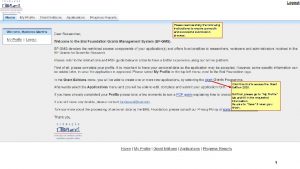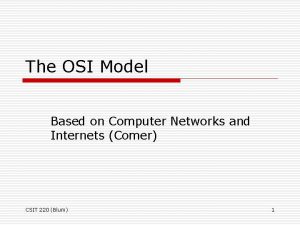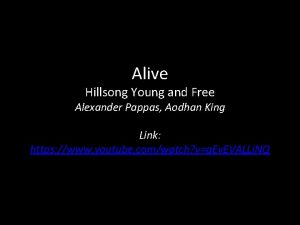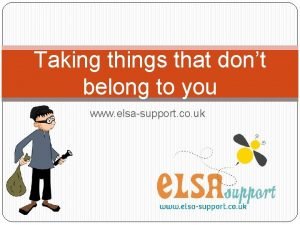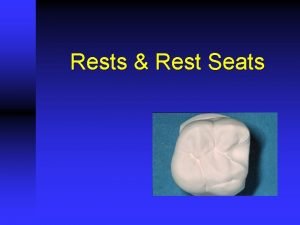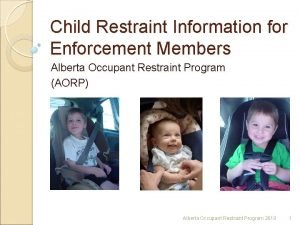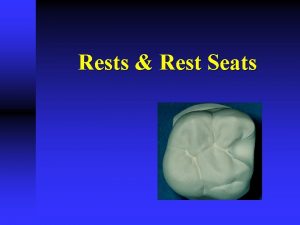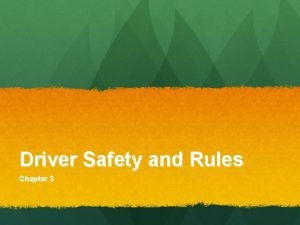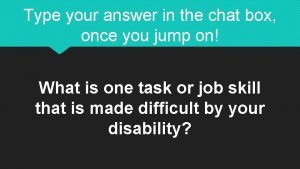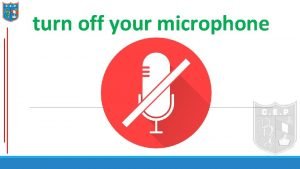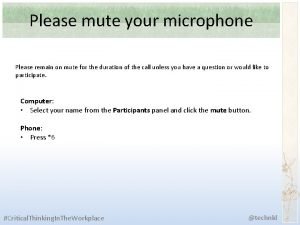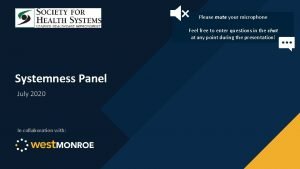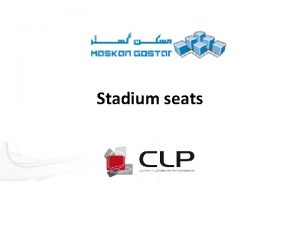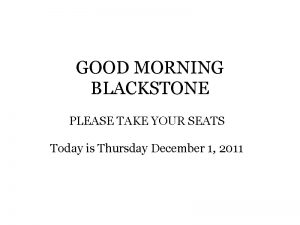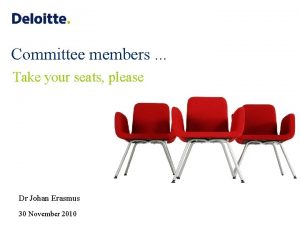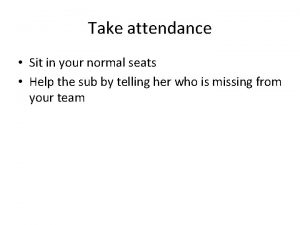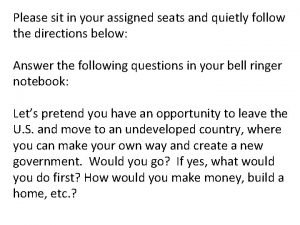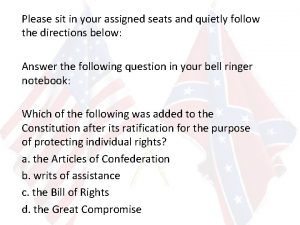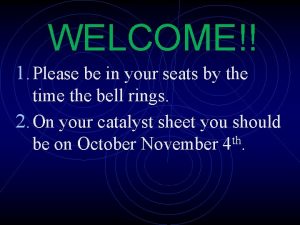AS YOU TAKE YOUR SEATS PLEASE FORM GROUPS







































- Slides: 39

AS YOU TAKE YOUR SEATS PLEASE FORM GROUPS OF 4 YOU MUST BE IN A GROUP WHERE YOU DO NOT KNOW THE OTHER PEOPLE THE GROUP MUST HAVE AT LEAST ONE MALE AND ONE FEMALE THE MORE DIVERSE THE BETTER AT LEAST ONE OF YOU MUST HAVE A PHONE THAT CAN ACCESS THE INTERNET

GRENAE DUDLEY, PH. D. PRESIDENT AND CEO THE YOUTH CONNECTION, INC.

The Homeless I Do Not See

Why Do You Think People Are Homeless?

The Homeless I Do Not See The Faces Of The Homeless We Choose To See Are Stereotypically The Drug Addicts, The Derelicts And The Mentally Ill.

THE HOMELESS I SEE Are Criminals Hard Headed Teenagers Who Want Their Own Way Are Drug Addicts And Winos Are Mentally Ill Are Too Lazy To Work Are The Result Of Their Own Poor Choices Want Freedom From Responsibility


Why Do People Become Homeless? Poverty Homelessness And Poverty Are Inextricably Linked. Housing A Lack Of Affordable Housing And The Limited Scale Of Housing Assistance Programs. Foreclosures Have Also Increased The Number Of People Who Experience Homelessness.

Why Do People Become Homeless? Lack Of Employment Opportunities Decline In Available Public Assistance And Affordable Health Care Aging Out Of Foster Care LGBTQ Domestic Violence Mental Illness Addiction

What Choices Will You Make? The Poverty Threshold For A Family Of 4 Is $438 Per Week, Which Is $1, 900 Per Month. Use Your Phone And Go To: http: //tinyurl. com/poverty 438 In Your Group Make The Choices And Report Out What You Have Remaining At The End Of The Month…. .

They Are Homeless Because Of Their Own Poor Choices! According To The Michigan Campaign To End Homelessness • The Average Income Of A Homeless Michigan Family Is $730 Per Month • Thirty-eight Percent (38%) Are Living With An Income Of Less Than $500 Per Month

DID YOU PAY THE RENT THIS MONTH? Woman Freezes To Death When Landlord Boots Her Out For $338 Unpaid Rent

The Homeless We Do Not See In Michigan During 2015 There Were An Estimated 99, 975 Homeless Category 1: 69, 163 Literally Homeless Living In Shelters And On The Street. Category 2: Estimated 30, 812 Imminently At Risk- Homeless, Documented Evictions And No Place To Go

You Are Homeless If:

The Literally Homeless Includes Any Individual Or Family Whose Primary Nighttime Residence Is A Public Or Private Place Not Meant For Human Habituation Including A Car, Park, Abandoned Building, Bus Or Train Station, Airport, Or Campground; Or Who Is Living In A Shelter On The Streets; Or Is Exiting An Institution Where S/He Has Resided For Less Than 90 Days

Chronic Homelessness Means Individuals Who Have: Documented Disability And Experience Homelessness 4 Or More Times In The Last 3 Years With Total Time At Least 12 Months Or Been Continuously Homeless For At Least 12 Months

Doubled Up Housing - A Term That Refers To A Situation Where Individuals Are Unable To Maintain Their Housing Situation And Are Forced To Stay With A Series Of Friends And/Or Extended Family Members

The Homeless I Do Not See If We Clear And Focus Our Attention We Will See, Families, Children, Runaway Abused Youth, Veterans, And Individuals Who May Even Work With Us. They Sleep Under Viaducts, Over Heating Grates, In Shelters, Under Bridges, In Cars, Behind Dumpsters, In Abandoned Buildings And In The Parks. To Address The Issues Of Homelessness We First Have To See Them.

The Homeless I Do Not See: 2015 Families With Children Sixty-five Percent (65%) Of Homeless Family Households In Michigan Were Composed Of A Single Female Parent With Young Children. Sixty-one (61%) Of Adults In Families Are Under Age 35, Twenty- Eight (28%) Had Dropped Out Of School Prior To Graduating. The Average Age Of Children That Are Homeless In Michigan Was 6. 9 Years Old, But The Highest Percentage (38%) Are Children Under The Age Of Five. 71% Of The Children Are Under The Age Of 11.

The Homeless I Do Not See: 2015 Families With Children Make Up Half Of The Homeless Population. Families With Children Forty-nine Percent (49%) Are White, 47% Are Black/African American And The Remaining 4% Are Composed Of Other Minorities. Nearly One-third (33%) Of Families That Were Homeless Were Working Poor With An Average Income Of $958 Per Month.

The Homeless I Do Not See: 2015 Singles Who Are Homeless Are Typically Older, Average Age Of 41. 5 With 19% Above 55. More Likely To Be A Racial Minority - 52% Black/African American And 5% Other. Predominately Male (63%); The Number Of Females Among The Single Population Increased By 3, 133 Persons In 2012. Single Persons Have A High Level Of Disability, 56%, Predominantly Mental Health Diagnoses And 30% With Addiction Issues, 27% With Chronic Health Conditions. Eighteen Percent (18%) Were Working With Seventy Percent (70%) Earning Less Than $500. 00 Per Month. Sixty-seven Percent (67%) Have At Least A High School Education. About One-quarter (25%) Are Identified As Chronically Homeless.

The Homeless I Do Not See: 2015 Unaccompanied Youth According To The 2014 State Of Homelessness In Michigan Report, 1, 190 Unaccompanied Youth Under The Age Of 18 Were Counted On The Streets And In Shelters. 16 Was The Average Age With 58% Being Female. Fifty-one Percent (51%) Of Those Youth Experienced Homelessness For The First Time. Seventy-six Percent (76%) Were Attending School With 19% Evidencing Attendance Problems. Six Percent (6%) Had Either Dropped Out, Been Expelled Or Suspended From School. Twenty-six Percent (26%) Had Identified Disabilities. Seventy-six Percent (76%) Had Primarily Mental Health Disabilities, 26% Had Developmental Issues.

The Homeless I Do Not See: 2015 Unaccompanied Youth Seventy Percent (70%) Of Michigan’s Enrolled Homeless Students Were Living In Doubled-up Housing; 22% Were Residing In Shelters, 5% Were Staying In Hotels/Motels; And 2% Were Unsheltered. Twenty-nine Percent (29%) Had Separated From Their Families More Than Once In The Past And 11% Had Long Histories Homelessness. Youth Homelessness Is Connected To Family Conflict, Abuse And Neglect, And Discrimination Based On LGBTQ Identity. Poverty, Coupled With A Loss Of Family Relationships Or Family Violence, Are The Key Factors For Why Youth End Up On The Streets

The Homeless I Do Not See: 2015 Unaccompanied Youth Many Youth Are Homeless Due To Family Dysfunction, Exiting The Child Welfare Or Juvenile Justice Systems, And Sexual Abuse. Research Has Shown That 21 -42% Of Runaway And Homeless Youth Were Sexually Abused Before They Left Their Homes. These Young People Often Flee Abuse And Violence At Home, But Are Exposed To Further Sexual Victimization And Human Trafficking Once On The Street.

Street Outreach Study funded by the Family and Youth Services Bureau Less Than 4% Of All Adolescents Exchange Sex For Money However 28% Of Youth Living On The Street And 10% Of Those In Shelters Engage In 'Survival Sex' In Exchange For Food, Shelter Or Money. Homeless Youth Are Also Vulnerable To Labor Trafficking Because The Traffickers Promise Them What They Don’t Have, Food, Housing And Employment.

The Homeless I Do Not See: 2015 Veterans Overall Average Age Of Male Homeless Veterans In Michigan Was 50 Years; However, 15% Were Under The Age Of 25 Representing More Recent Military Service. Average Age For Female Veterans Was 41 years. Eighty-six Percent (86%) Were Men. Veteran Had A Higher Rate Of Disabilities Than Civilian Homeless (65%) Vs 37% Civilian Homeless. Most Common Disabilities Were Mental Health, 55%, Medical, 52%, And Substance Abuse, 33%. Veterans Had A Higher Rate Of Education Beyond High School: 42% Veterans Vs. 28% Civilian. Thirty-five Percent (35%) Were First Time Homeless. Twenty-Seven Percent (27%) Had Been Homeless One Or Two Times In The Past With 24% Meeting The Definition Of Being Chronically Homeless. Veterans Had A Higher Average Monthly Income $1, 089

The Homeless I Do Not See: 2015 Seniors The Senior Homeless Population Continues To Grow Significantly Each Year. Sixty-eight Percent (68%) Have A Documented Disability. Fifteen Percent (15%) Was Age 65 Or Older. Seventeen Percent (17%) Qualified As Chronically Homeless. Among Chronically Homeless Seniors, 50% Confirmed Significant Health Issues.

On Any Given Day January, 2016 The Department Of Housing And Urban Development (HUD) Releases The Annual Homeless Assessment Report To Congress (AHAR) Which Includes Point-in-time (PIT) Estimates, Offering A Snapshot Of Homelessness — both Sheltered And Unsheltered — on A Single Night. The One-night Counts Are Conducted In Late January Of Each Year.

2015 Homelessness In Michigan Is Not Just A Big City Issue. The Map Represents The Total Projected Number Of Literally Homeless By Region

Types of Available Services Street Outreach Emergency Shelters Transitional Housing Rapid Rehousing Permanent Supportive Housing Voucher Programs

How You Can Help Be Informed Language choices Try To Avoid Using Negative Labels Like “Bum” Or “Hobo” When Referring To People Experiencing Homelessness. By Using The Phrase “People Experiencing Homelessness, ” Be Aware Of Who May Need Assistance Connect To Resources In Your Community That Assist The Homeless: Department Of Health And Human Services, Housing Authority, Veterans Organizations, Department Of Education, Children Service Agencies, Domestic Violence Shelters

How You Can Help Facilitate Job Opportunities Encourage Your Company, School, Or Organization To Hire People Experiencing Both Homelessness And Unemployment. Volunteering Time (Even If Only A Few Hours A Week) At Your Local Homeless Shelter Is A Tremendous Help. This Could Include Working In The Kitchen Or Doing Administrative Or Clerical Work. You Could Also Volunteer To Help Fix Up Shelters Or Houses. Follow Local Politics It Sounds Very Simple, But Simply Staying Informed And Staying Vocal Is Also A Great Way To Help Raise Awareness Of The Problem.

How You Can Help Put Together A Resource Guide To Have For Your Staff Include Domestic Violence Shelters Take The Time To Participate In Homeless Coalitions In Your Community What Agency Polices Do You Have To Assist The Homeless Other Than Calling The Police? MDNR Has A Seat On The Michigan Interagency Council On Homelessness: Mark Hoffman Is The Current Department Designee

Listing By Service Area Of The Michigan Continuum Of Care Organizations http: //tinyurl. com/MIHomeless Continuum Of Care (Co. C) Program The Continuum Of Care (Co. C) Program Is Designed To Promote Communitywide Commitment To The Goal Of Ending Homelessness; Provide Funding For Efforts By Nonprofit Providers, And State And Local Governments To Quickly Rehouse Homeless Individuals And Families While Minimizing The Trauma And Dislocation Caused To Homeless Individuals, Families, And Communities By Homelessness; Promote Access To And Effect Utilization Of Mainstream Programs By Homeless Individuals And Families; And Optimize Self-sufficiency Among Individuals And Families Experiencing Homelessness. Are You Interested In Volunteering? Please Contact The Continuum Of Care In Your Area.

Project Homeless Connect (PHC) Is Designed As A 'One-stop, One-day' Community Oriented Event For Individuals Who Are At Risk Of Becoming Homeless Or Are Already Homeless. These Events Are Collaborations Of A Local Continuum Of Care Body And Endeavor To Bring Together Community Resources That Can Support Individuals And Families In Times Of Economic Hardship. These Range From Typical Social Service Providers To Free Goods And Services.

https: //www. referweb. net/call/ Housing + Utilities If You're Looking For Access To Safe, Habitable, And Clean Housing, 2 -1 -1 Can Help. Whether You're In Need Of New Housing, Utilities Assistance, Or Financial Support For Much-needed Home Repairs, 211 Directs You To The Right Resources. Start Here To Find Emergency Shelters For Individuals And Families In Crisis. Learn About Programs That Offer Rental Assistance, Subsidized Housing, And Housing Vouchers That Can Help Families, The Elderly And Disabled Individuals Pay For Housing. If You’re Struggling To Keep Up With Your Energy And Utility Bills, Use 2 -11

The Michigan Coalition Against Homelessness (MCAH) Is A Nonprofit Membership Organization Formed As An Association Of Emergency Shelters, Transitional Housing Programs, Nonprofit Housing And Service Programs, Government Programs And Concerned Citizens From Across The State. Michigan’s 10 Year Plan To End Homelessness Updated September, 2013

“We Think Sometimes That Poverty Is Only Being Hungry, Naked And Homeless. The Poverty Of Being Unwanted, Unloved And Uncared For Is The Greatest Poverty. ” - Mother Teresa

 Will you please be quiet please themes
Will you please be quiet please themes You take $100 you had kept
You take $100 you had kept You put your right hand in
You put your right hand in Please read the carefully before you fill out the form
Please read the carefully before you fill out the form How are ethnic groups and religious groups related
How are ethnic groups and religious groups related Poetrywithpassion
Poetrywithpassion Welcome please take a seat
Welcome please take a seat Please don't throw sausage pizza away
Please don't throw sausage pizza away Sit in your seat
Sit in your seat Please take a seat
Please take a seat Take prepositional phrase
Take prepositional phrase Please take out some time
Please take out some time Notes on oedipus the king
Notes on oedipus the king Hillsong young & free alexander pappas
Hillsong young & free alexander pappas You say you love the rain
You say you love the rain Take a bus or take a train
Take a bus or take a train To take something that doesn't belong to you
To take something that doesn't belong to you The more you take the more you leave behind
The more you take the more you leave behind 10 examples of zero conditional sentences
10 examples of zero conditional sentences If you ask him he (take) you to the airport
If you ask him he (take) you to the airport Whats vip at vue
Whats vip at vue Cingulum rest prep
Cingulum rest prep Minimizer truck seat
Minimizer truck seat Booster seat regulations alberta
Booster seat regulations alberta Lingual rest seat
Lingual rest seat Whenever possible, child car safety seats should be placed
Whenever possible, child car safety seats should be placed A theater has 490 seats
A theater has 490 seats Construction equipment seats
Construction equipment seats Www.myidtravel/listing
Www.myidtravel/listing Nissan stadium renovations
Nissan stadium renovations Give us your hungry your tired your poor
Give us your hungry your tired your poor Type in the chat box
Type in the chat box Turn off microphone
Turn off microphone Please keep your mic muted
Please keep your mic muted Please mute your phone
Please mute your phone Come in and ....................... a seat!
Come in and ....................... a seat! Please sit down and your seat belts
Please sit down and your seat belts Toxic polyamory
Toxic polyamory Please mute your microphone when not speaking
Please mute your microphone when not speaking Please put your homework my desk
Please put your homework my desk



